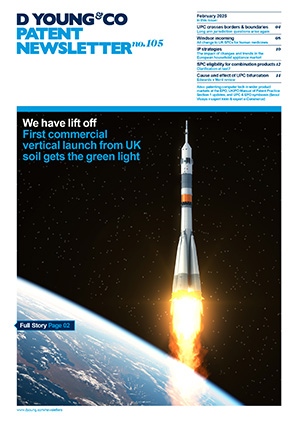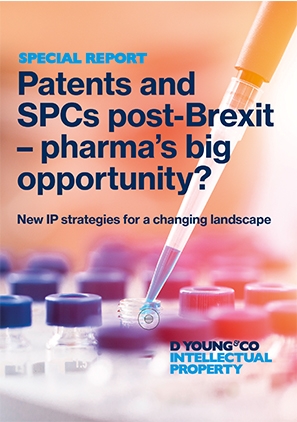AI (part two): inventorship and ownership
The UK Intellectual Property Office’s recent consultation on artificial intelligence and intellectual property prompted 92 responses including one from D Young & Co. Following the recent publication of the consultation outcome, we consider some of the issues raised. In this second article, we consider the issues of inventorship and ownership for inventions arising from AI, and in particular whether patent law should allow an AI to be identified as a sole or joint inventor.
AI - part one
In the first article of this series, we looked at the definition of AI and how this interacts with excluded subject matter provisions in UK (and European) patent law:
Read moreLooking to UK statute for guidance, Section 3 of the UK Patents Act defines an invention on its own merits and without regard to the status of the inventor. Hence in principle a new and non-obvious concept can be an invention even if it was solely or partially contributed to by an AI.
However, section 7(2) of the act then lists who can be granted a patent, which includes the inventor (or their employer or an assignee, etc), and “no other person”. This makes plain that an inventor must be a person, and so appears to exclude AIs as inventors.
The recent DABUS case relating to an application which named an AI as the sole inventor (Thaler v Comptroller [2020] EWHC 2412 (Pat)) and the corresponding EPO decision, reached a similar conclusion that the DABUS AI system could not be an inventor by definition because it was not a person.
Whilst this may appear reasonable, it is also problematic – with no inventor, there can be no corresponding right to a patent. So if a new and non-obvious concept is generated by an AI, what can be done to obtain a patent?
We suggest that the problem stems from the assumption that an AI can invent.
Following on from section 7(2), section 7(3) of the UK Patents Act defines the inventor as the ‘actual deviser’ of the invention. By contrast, section 43(3) excludes anyone who merely advises or assists the inventor. Hence the law implies inventorship requires some form of forethought, insight, and/or appreciation of the problem to be solved, whilst distinguishing these from inputs to the invention that does not require such things.
If this is the bar set for inventorship, then current AIs do not meet the criteria.
So what are AIs doing, if not inventing?
We suggest that such AIs should be treated as a means to discover new and non-obvious properties that are latent within a space occupied by their training set and inputs. In this sense, an AI may discover, but not invent, a new thing.
This property appears innate to how AIs work; an AI creates an internal representation of features of its training set, and so the information available to the trained AI is thus typically a partial and transformed representation of the training set, as determined by the type of AI. Sometimes an input may also be used by the AI as a baseline or scaffold for using its internal information, and act as a stimulus for the AI’s output or functionality.
Hence all the AI’s possible outputs are a function of its internal information derived from the training set and optionally the current input. These have been provided, arranged, or caused by the curator of the training set, the AI architect, and/or the user, and are latent within the trained system and any input. The outputs or functions of the AI are thus explorations of (and limited by) this latent space and can be better thought of as discoveries within it.
In this case, in a manner analogous to existing case law relating to drug discovery or gene discovery, an industrial application of a new and non-obvious discovery made with the AI may then be inventive. The bar for this industrial application can be very low since by definition, being based upon a new and non-obvious discovery, it will also be new and non-obvious.
Hence a claim making such use of a new and non-obvious output or functionality of an AI system should be an invention (leaving patentability as a separate issue). Typically it will just be a matter of placing the discovery within the context of the general use that motivated its creation in the first place.
Thus by considering an AI a tool for discovery - albeit a seemingly creative one - the industrial application of its discovery (for example, by a person) is inventive, and can attract patent rights in the normal manner.
This approach avoids most of the pitfalls relating to issues of inventiveness by AIs.
Firstly, it is independent of the type of AI being used. This avoids any issues relating to how an AI invented or identified an invention. Notably it also avoids the need for an ‘explainable’ or ‘transparent’ AI that reveals a specific path of determination for producing the result, since the history behind a discovery is not essential to its industrial application.
Secondly, the approach is consistent with existing precedent for automated discoveries and industrial exploitation in genetics and chemistry. It should also be appreciated that the principle should apply to any AI that discovers a new and non-obvious thing, whether that thing is a one-shot output, a complex behaviour, or an ongoing relationship between inputs and outputs.
Thirdly it avoids the need for any new legislation or rules relating to AI inventorship or co-inventorship, and sidesteps any parallel issues such as who the corresponding skilled person in the art may be.
We therefore conclude that existing AIs are capable of discovering new and non-obvious things latent within the domain of their training set and inputs, and the industrial application of these discoveries by legal persons are in principle inventive. We believe that this is the best approach to the determination of what has been invented and hence also who is the inventor.
This in large part also resolves the problem of ownership, as this will follow conventional paths flowing from the industrial exploitation of the discovery.
Whilst the above discussion relates to inventions, it will be appreciated that the outputs of many AIs do not fall under this category, but might be relevant to other forms of IP – in particular copyright and design rights.
Fortunately, UK legislation in these fields already accommodates AIs, based on the following general provision:
“In the case of a work which is computer-generated, the author shall be taken to be the person by whom the arrangements necessary for the creation of the work are undertaken.”
Variants on this provision can be found for copyright in section 9(3) CDPA; for unregistered design right in section 214(2) CDPA; and for registered design right in section 2(4) RDA. Meanwhile for registered trade marks, authorship is not a determining factor.
Clearly this also provides a model for a potential legislative solution for patents if AIs are still considered ineligible inventors, with a corresponding section or rule conferring inventorship on the person(s) who arranged for the AI to invent. Notably in the UK Government’s response to the consultation, they propose a new consultation later this year on a range of policy options including legislative change, for protecting AI generated inventions that would otherwise not meet current inventorship criteria. This is a positive step, and we will engage with the consultation when it is announced.
In particular, within such a legislative solution it should be recognised that the person who undertook the arrangements necessary for the production of the invention may not necessarily be the person who built or trained the AI. The specific contributors to a given invention will be a question of fact.
For closed domain systems, the necessary arrangements may indeed be providing the training set and any process used to create the AI, which will have been selected to determine what the AI does. Clearly, an AI trained to distinguish cats from dogs will never generate a new protein model or circuit layout; the creator(s) of the AI have determination over the domain of application by the AI. Hence a person will have made the arrangements necessary for the production of the invention, even if they could not anticipate the exact embodiment that the AI produced.
By contrast for an open-domain AI such as GPT-3 (a system that has been trained on any and all content within large public databases to act, in effect, as a generalised predictor), the inventor is likely to be the person who - in appreciation of a problem that needs solving - constructs a task for the open domain AI to solve in a desired manner.
Meanwhile even for self-training systems such as AlphaGo Zero, the ability to experiment and observe for the purpose of self-training, the domain in which that experimentation occurs, and the ultimate goal, are provided and enabled by the developers of the system.
Hence we believe that even if an AI was considered a sole or joint inventor, a new rule similar to the provision in s9(3) CDPA could address the issue of entitlement to own a resulting patent – but it should be flexible in recognising who the corresponding inventor is.
In conclusion, whether AIs are ultimately treated as a means of discovery, or a means to invent, there appear to be legal mechanisms either in place or easily modelled that enable ownership and hence patentability to proceed, and the UK Government are being proactive in ensuring that this happens.
UK Government issues response to AI call for views (23 March 2021)
Read more

